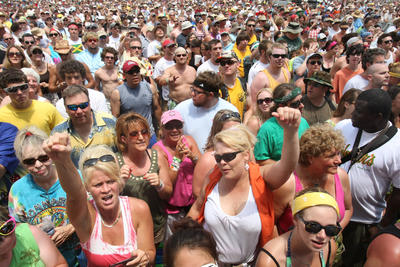
At first glance, Bonnaroo 2010 looked like any other Bonnaroo. Girls in bikinis and sun dresses. Guys in tie-dies and streetwear. But Bonnaroo has actually gone through a complete changeover in its audience, as the more diverse lineup has predictably brought out a whole new crop of campers with decidedly mainstream tastes. The incredible thing, though, is that Bonnaroo has changed without changing.
True fans of live improvisational music have moved toward regional festivals like Wakarusa (sold out this year at 17,000) and newcomer Nateva (camping tix sold out). Meanwhile, Bonnaroo is now the place where the masses go to act like hippies for a weekend.
The shift was already evident last year when, ironically, Phish was the headliner. I realized this only because of the HeadCount “Reality Check” gameshow, a festival-wide music and political trivia tournament. Our music questions were provided by Relix magazine and, appropriately, had a healthy mix of Phish, Dead and jam band questions. What we realized pretty quickly is that most people weren’t getting those questions right. “Gamehenge?" “Pigpen?" Wasn’t happening. A question about naming one of two guitarists from Umphrey’s McGee proved to be the least correctly answered question in our pile.
I was really surprised, but it was unmistakable. Even as a headliner , Phish wasn’t the most popular band in the crowd. And with neither Phish or any arena-level improv rock band on the bill this year, the jam scene left with them. There were almost no hardcore Phish, Grateful Dead or Widespread Panic fans flying their colors.
But here’s the most amazing thing. Nothing else changed. The look is the same. The feel is the same. The fashion is mostly the same.
It took really paying attention to the crowd to notice even the subtle differences. But I’m kind of a student of faces at festivals (it’s creepy, I know). And here’s exactly what I saw:
- A few dudes with dreads. A few. Like, maybe a dozen total.
- A large number of 30+ guys in cheesy tie-dies, especially bootleg concert t-shirts.
- Gay women. Lots of them. More than I can count.
- Large groups of very young girls.
- People of color. By far more than I’d ever seen at any Bonnaroo before. Generally in groups where everyone else was white. But for the first time, there were probably more non-whites in the crowd than backstage.
- Semi-tough looking dudes with headbands or bandanas.
- No celebrities. I heard Matthew Fox was there, and an NHL player. Didn’t see them though.
- Huge crowds and great enthusiasm for all three headliners – Kings of Leon, Jay-Z and Dave Matthews Band
- Equally packed crowds for second stage acts Phoenix, Weezer, and Michael Franti
- Consistently large crowds at the new Lunar (electronic music) stage throughout the weekend
- At least 4,000 people watching the live simulcast of World Cup soccer
- Relatively light crowds, as in not completely packed, at almost all the tents including the prime latenight acts like LCD Soundsystem.
- Not a single “wasted” person.
- A very mellow shakedown street in the general camping area, with little activity following Jay-Z’s headline set on Saturday night.
- Not a single person openly selling drugs.
- A dude selling baby turtles.
Yeah, at the end of the night, a guy who was clearly there not for the music but for the money, was selling baby turtles. I asked the guy why he was at Bonnaroo. “I’m selling baby turtles,” he said.
“Are people buying them?”
“Hell yeah.”
Random as it may seem, I think this actually was the most telling imprint of the shifting sands of Bonnaroo. It’s illegal to sell baby turtles because they spread salmonella. It pops up in places like New York’s Chinatown where there’s a ton of people and little enforcement. It basically caters to the mainstream, anyone with a little cash and a soft spot for cute, hard-shelled animals. It's also about the lowest level of petty crime there is (animal rights activists may differ).
So this is the dark underbelly of mainstream Bonnaroo. I have witnessed what happens to a great festival once discovered by the masses. No violence. No vandalism... Just dudes selling baby turtles.
It's because the Bonnaroo experience sets the tone and defines the aesthetic. Everyone buys in. The new audience might even be a little better behaved than the old one. Cops are still non-existent and unnecessary. The sketchy parking lot element is gone. And no single band or genre owns the crowd.
This is the complete realization of the vision Bonnaroo’s founders -- Superfly Presents -- had back in 2002. They always said they didn’t want to throw a jam band festival. They just wanted to throw a great festival. So concepts like requiring sponsors to enhance the fan experience, or having the word “SAFETY” stamped on security guards’ shirts – those sort of things created a truly enduring environment. As they added more and more entertainment, bigger and bigger acts and crazier concepts, they never got away from the core idea of what a great festival should be.
This proved to have popularity well beyond the cozy confines of the festival circuit. Changes in the lineup or the makeup of the crowd can’t change that. Nothing can overpower the vibe that is Bonnaroo.